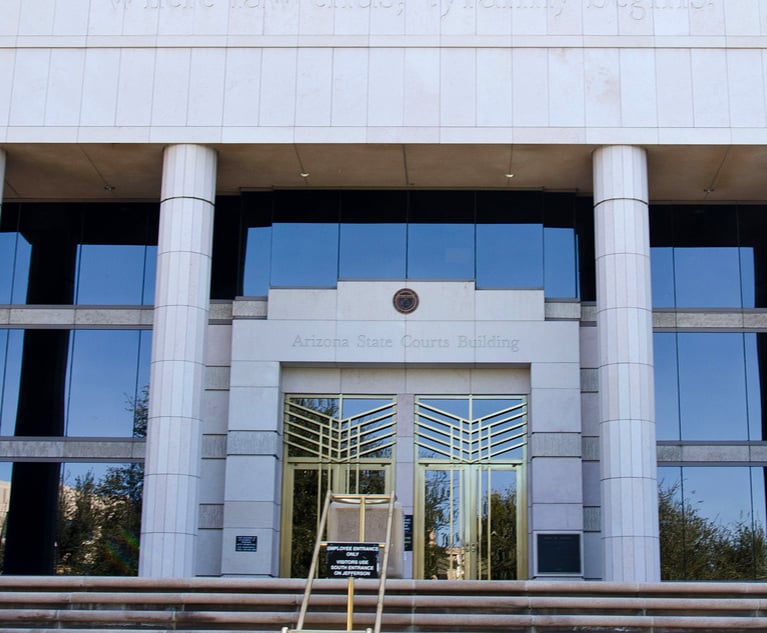Management: Betting on the big four
The big four magic circle firms (Allen & Overy, Clifford Chance, Freshfields Bruckhaus Deringer, Linklaters) have had an incredible run over the past 15 years. All of them achieved the benchmark of extraordinary success for a large law firm - profits per equity partner (PEP) near or over $2m (£1.4m) and gross revenues of around $2bn (£1.4bn). What made their success all the more impressive was that in the early 1990s their standing was less than 'magical' relative to premier US firms. As much as these firms achieved over these last 15 years, the current economic crisis raises real questions about how they will fare in the future.
March 18, 2009 at 08:33 PM
5 minute read
Projections show that the UK's big four magic circle law firms are set to continue their meteoric success, long after the economic downturn is over. Peter Sherer says put your money on it
The big four magic circle firms (Allen & Overy, Clifford Chance, Freshfields Bruckhaus Deringer, Linklaters) have had an incredible run over the past 15 years. All of them achieved the benchmark of extraordinary success for a large law firm – profits per equity partner (PEP) near or over $2m (£1.4m) and gross revenues of around $2bn (£1.4bn). What made their success all the more impressive was that in the early 1990s their standing was less than 'magical' relative to premier US firms.
As much as these firms achieved over these last 15 years, the current economic crisis raises real questions about how they will fare in the future.
To answer this question, let's first put things in perspective. With the aid of a statistical tool called cluster analysis, I grouped Global 100 firms on the basis of the likeness of their 2007 PEP and gross revenues, in what strategy researchers call strategic groups. Figure 1 shows six strategic groups among Global 100 firms, with PEP in millions on the Y-axis, gross revenues in billions on the X-axis, and the size of the circles corresponding to the number of firms in a group. The big six – the big four magic circle plus Skadden Arps Slate Meagher & Flom and Latham & Watkins – averaged PEP over $2m and gross revenues of $2bn. Wachtell Lipton Rosen & Katz stood by itself at PEP of nearly $5m (£3.5m). Another exceptional group, including Cravath Swaine & Moore, Sullivan and Cromwell and Slaughter and May, averaged almost $3m (£2m) in PEP and close to $750m (£535m) in revenues.
What might we expect in the future from the big four? A way of envisioning the future is to extrapolate out trends with historical growth rates. That allows us to very clearly project what history holds for the future. We then play those projections off our intuitions as to what might actually happen. This contrast between projections and what our intuition tells us will happen is especially critical today because we know the current economic crisis is changing the future of firms.
Projections for 2025 for the Global 100 were generated from compound annual growth rates (CAGRs) using historical data on PEP and gross revenues from the Global 100, Am Law 100, and Legal Business 100. (Projections for the Global 100 on profits per equity partner and gross revenues appeared in the October 2008 issue of The American Lawyer.) The projections capture what we would expect to be the future of these firms in 2025 based on historical trends, subject to no major change in the world.
What is most important from these projections is not the exact numbers but the relative standing of firms. By generating a strategic mapping of the future, as shown in Figure 2, we can readily see where firms stand. The big six would become the big seven – the big four, Skadden, Latham and the new addition, DLA Piper USA. DLA Piper International would outdo the Big Seven. Slaughters would be in a small club with the likes of Wachtell, Cravath and Sullivan. Greenberg Traurig would be the behemoth of law firms.
Will this scenario play out? That is, will the big four firms weather the storm in the shake-out that is surely coming and proceed as expected into the future? Better yet for the big four, will they outperform their projected future? Or, will they lose out and end up in more contested space?
Lots of factors played into the success of the big four, some outside of their control. But I will argue that when the dust settles, the big four will come out the stronger for it.
What the big four have going in their favour is a business model that calls for integrating vast size and geographical reach so as to create a global law firm that has the connectivity of a one-city firm. In the model, individual lawyer, practice group and office autonomy are second to the greater good of the firm. The big four do this by sticking with yet revising elements of partnership from the past, such as lockstep compensation. In this respect, the big four business model is a revision of the traditional model of partnership found in several premier US firms, updated to meet the demands of a global law firm.
Of course, firms with very different models just might do better. DLA Piper International stands out. It succeeded by aggressively breaking traditions. From 2000, it had a striking CAGR for PEP of approximately 14% and for gross revenues of 22%.
But if I were betting on law firms, or better yet, purchasing stock in them, I would put my money in the big four. Their business model allowed for sustained growth in tough times and that resiliency portends well for them. Their business model puts a new light on the past that just might be the way of the future, even in these most difficult times.
Peter Sherer is an associate professor of management at Haskayne School of Business, University of Calgary.
Related event: Legal Week Future of Legal Services Forum
This content has been archived. It is available through our partners, LexisNexis® and Bloomberg Law.
To view this content, please continue to their sites.
Not a Lexis Subscriber?
Subscribe Now
Not a Bloomberg Law Subscriber?
Subscribe Now
NOT FOR REPRINT
© 2025 ALM Global, LLC, All Rights Reserved. Request academic re-use from www.copyright.com. All other uses, submit a request to [email protected]. For more information visit Asset & Logo Licensing.
You Might Like
View All

Some Elite Law Firms Are Growing Equity Partner Ranks Faster Than Others
4 minute read
KPMG's Bid To Practice Law in US On Hold As Arizona Court Exercises Caution
Trending Stories
Who Got The Work
J. Brugh Lower of Gibbons has entered an appearance for industrial equipment supplier Devco Corporation in a pending trademark infringement lawsuit. The suit, accusing the defendant of selling knock-off Graco products, was filed Dec. 18 in New Jersey District Court by Rivkin Radler on behalf of Graco Inc. and Graco Minnesota. The case, assigned to U.S. District Judge Zahid N. Quraishi, is 3:24-cv-11294, Graco Inc. et al v. Devco Corporation.
Who Got The Work
Rebecca Maller-Stein and Kent A. Yalowitz of Arnold & Porter Kaye Scholer have entered their appearances for Hanaco Venture Capital and its executives, Lior Prosor and David Frankel, in a pending securities lawsuit. The action, filed on Dec. 24 in New York Southern District Court by Zell, Aron & Co. on behalf of Goldeneye Advisors, accuses the defendants of negligently and fraudulently managing the plaintiff's $1 million investment. The case, assigned to U.S. District Judge Vernon S. Broderick, is 1:24-cv-09918, Goldeneye Advisors, LLC v. Hanaco Venture Capital, Ltd. et al.
Who Got The Work
Attorneys from A&O Shearman has stepped in as defense counsel for Toronto-Dominion Bank and other defendants in a pending securities class action. The suit, filed Dec. 11 in New York Southern District Court by Bleichmar Fonti & Auld, accuses the defendants of concealing the bank's 'pervasive' deficiencies in regards to its compliance with the Bank Secrecy Act and the quality of its anti-money laundering controls. The case, assigned to U.S. District Judge Arun Subramanian, is 1:24-cv-09445, Gonzalez v. The Toronto-Dominion Bank et al.
Who Got The Work
Crown Castle International, a Pennsylvania company providing shared communications infrastructure, has turned to Luke D. Wolf of Gordon Rees Scully Mansukhani to fend off a pending breach-of-contract lawsuit. The court action, filed Nov. 25 in Michigan Eastern District Court by Hooper Hathaway PC on behalf of The Town Residences LLC, accuses Crown Castle of failing to transfer approximately $30,000 in utility payments from T-Mobile in breach of a roof-top lease and assignment agreement. The case, assigned to U.S. District Judge Susan K. Declercq, is 2:24-cv-13131, The Town Residences LLC v. T-Mobile US, Inc. et al.
Who Got The Work
Wilfred P. Coronato and Daniel M. Schwartz of McCarter & English have stepped in as defense counsel to Electrolux Home Products Inc. in a pending product liability lawsuit. The court action, filed Nov. 26 in New York Eastern District Court by Poulos Lopiccolo PC and Nagel Rice LLP on behalf of David Stern, alleges that the defendant's refrigerators’ drawers and shelving repeatedly break and fall apart within months after purchase. The case, assigned to U.S. District Judge Joan M. Azrack, is 2:24-cv-08204, Stern v. Electrolux Home Products, Inc.
Featured Firms
Law Offices of Gary Martin Hays & Associates, P.C.
(470) 294-1674
Law Offices of Mark E. Salomone
(857) 444-6468
Smith & Hassler
(713) 739-1250









